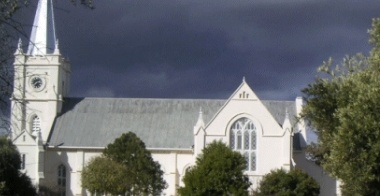|

Bethulie is a small, historical town in the southern Freestate province on the northern banks of the Gariep Dam, about 90 minutes drive (185Kms) from Bloemfontein. Bethulie serves a cattle and sheep farming area.
Historical and tourism information
Bethulie and its surrounds are rich in history. Second only to the environment, history is what makes the area worth visiting. Fossils as old as 260 million years have been found, including Procolophon, Lystrosaurus, Proterosuchus, Lydekterina and Thrinaxodon. There are also remains of an ancient lake 230 million years old.
Before the missionaries
RJ Gordon reached the Groot Rivier about 10 km west of the present Bethulie and renamed it the Orange River. In 1803 Governor JW Janssens travelled to this area and in 1809 Colonel Richard Collins reached the confluence of the Caledon and Orange Rivers where he gave the Caledon its western name. Nomadic farmers were visitors to the region in 1820 already. The Bushmen were the first inhabitants of the area. RJ Gordon made sketches in 1777 where he noted seeing six Bushmen in the vicinity of where the northern point of the Steyn bridge is now. A considerable number of Bushmen paintings can be seen in the region.
Missionary era
James Clarke and GA Kolbe of the London Missionary Society did missionary work among the Bushmen from 1828-1833. JP Pellissier of the Paris Missionary Society did similar work from 1833-1867 among the Batlhapin who had followed him from Zeerust. Their captain was Lephoi.
Founding of the town
A dispute erupted between Pellissier and Lephoi after the latter sold the ground of the mission station to migrant farmers. A syndicate of migrant farmers bought the ground in 1860 and acquired 6000 morgen for the establishment of a town. In 1863 the town was proclaimed under the name of Heidelberg.
Anglo Boer War
The first participation of Bethulie burghers was in the Battle of Stormberg on 10 December 1899.The Boers blew up the train bridge across the river in 1900. Three burghers died in the skirmish at the old wagon bridge on 10 March 1900. The British occupied Bethulie in 15 March and placed the town under military control. The concentration camp began in April 1901 just outside the town where between 4800- 5000 people were contained. In the following 13 months 1714 women and children died there.
The building of the Gariep dam
The building of the Gariep dam and the establishment of the Tussen-die-Riviere game reserve was far-reaching. Bethulie lost 60% of its land area. The dam was completed in 1971. The railway had to be moved. The old road and rail bridges had to be dismantled. The old station, built in 1894, had to be closed and a new station at the opposite end of town had to be built in 1970.
|




